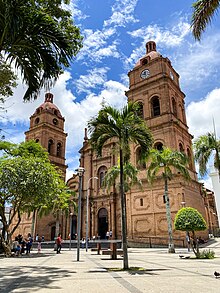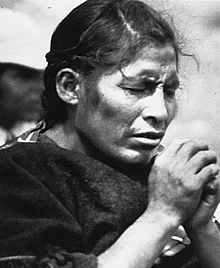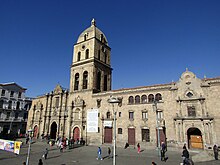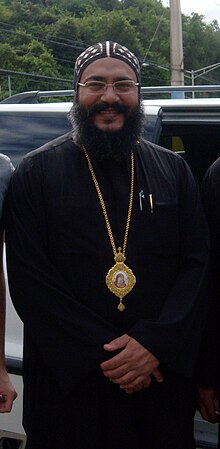Religion in Bolivia

Statistics
A 2018 survey for Latinobarometro returned these results:[3]
| Religion | Percentage of Population | Notes |
|---|---|---|
| Catholic | 70.0% | 36% of Catholics are active |
| Protestant (census term: Evangelical) | 17.2% | Pentecostal, Non-Catholic Charismatic, Lutherans, Methodists, others. 59% of them are active |
| Non-religious | 9.3% | Atheist, None, Agnostic, nothing in particular |
| Mormon/Jehovah's Witness | 1.7% | |
| Other religion | 1.2% | Jewish, Muslim
|
| No answer | 0.6% |

Other reviews of the population vary from these specific results.[4]
Religious freedom
The constitution of Bolivia establishes the freedom of religion and a separation between church and state. The constitution further prohibits discrimination along religious lines.[5]
Religious and spiritual belief organizations are required to register with the Ministry of Foreign Affairs and acquire a national legal personality. Until 2019, when the “law on religious freedom, religious organizations and spiritual beliefs” (LEY Nº 1161) was promulgated, there was an exception for the Catholic Church. Since then, all religions and spiritual beliefs are treated the same, according to law. The same law also establishes a principle of mutual respect, “within the framework of interculturality”.
Public, confessional, and private schools have the option to include religious studies in their curricula. All schools are required to avoid dogmatic imposition and teach ethics courses which emphasize religious tolerance and interreligious dialogue.[5] Confessional schools and universities have a significant presence in all major cities.
Some smaller churches in the evangelical Christian community have refused to register with the government, citing concerns for their privacy. While these groups have been unable to open bank accounts or hold property, the state has not otherwise interfered with their religious practice.[5]
Christian groups have alleged that governments led by Movimiento al Socialismo show a preference toward indigenous religious groups and practices. Conservative and right-wing parties on the other hand tend to privilege Christian beliefs, as evidenced before the accession to power of Jeanine Áñez in 2019 (“The Bible returns to the Government Palace”).
In rural areas of the country, hostility by indigenous communities against Christian missionaries has been reported; in some cases, these incidents have included cases of “indigenous leaders hitting pastors”.[5]
Christianity
Catholicism
Colonial era
Christianity had its roots in the Spanish conquest; priests accompanied the first military expeditions.
The patronato real (an agreement between the Catholic Church and the Spanish crown) gave the Spanish throne and, by extension, the colonial authorities significant powers in church affairs.[2] Appointments of clergy and bishops normally required the approval of civil authorities.[2] The relationship between church and state was mutual and intimate; each institution had great influence on the other's affairs.[2] In a society where separation from the religious ministrations of the church was unthinkable, the church had great moral influence.[2]
In addition, the colonial church was an extremely wealthy institution.[2] Religious organizations not only owned extensive tracts of land but also served as quasi-official moneylenders to the landed elite and high-ranking officeholders.[2] By the end of the colonial era, a combination of money lending and shrewd real estate investments had made the church the dominant financial power in Bolivia.[2]
Independence

Independence in 1825 brought some changes to Bolivian church-state relations, though the Roman Catholic Church retained its status as the nation's sole religion.
Further changes occurred in the twentieth century.[2] In 1906 the government proclaimed religious toleration and permitted the establishment of non-Roman Catholic churches.[2] In 1961 the government relinquished its right under the patronato nacional (the successor to the patronato real) to mediate in church affairs.[2] No longer could the government have a voice in conciliar decrees, briefs, or bulls that the pope issued or play a role in the selection of high-ranking church officials.[2] The Constitution of 1967 grants official status to the Roman Catholic Church but also guarantees the public exercise of all other religions.[2]
Freed from direct government control, the Roman Catholic Church in the 1960s attempted to establish a more visible presence in Bolivian society.
The political stance of ISAL-Bolivia and others engendered a sharp response from the bishops.
The return of democracy in the 1980s presented the church with a new set of challenges.
In 1986 the Roman Catholic Church was organized into four
Because of the church's weak rural presence, the vast majority of Indians followed their own brand of folk-Catholicism far removed from orthodoxy.[2] Indians saw no inconsistency in mixing professed Roman Catholicism with folk curers or indigenous ritual.[2] Indigenous rituals and fragments of Roman Catholic worship were interwoven in the elaborate fiestas that were the focus of social life.[2]
Coptic Orthodox church

There is a Coptic Orthodox church in Bolivia with Youssef (Joseph) as Bishop of the Holy Diocese of Santa Cruz and all Bolivia.[7]
Protestantism and other Christians

In the 1980s, Mormons, Jehovah's Witnesses, Seventh-day Adventists, and members of a variety of Pentecostal denominations gained increasing numbers of adherents among the rural and urban squatter populations.[2] Because these denominations tended to emphasize individual salvation and to deemphasize social and political issues, many leftists charged that they were agents of the United States government.[2] In May 1989, left-wing terrorists murdered two Mormon missionaries from the United States who had been working in a squatter community near La Paz.[2]
Bolivia has an active Protestant minority of various groups, especially Evangelical
Religious syncretism among indigenous groups
The
Other religions
Baháʼí Faith
The
Islam
Islam was brought by immigrants from Middle Eastern countries such as Palestine, Iran, Syria and Lebanon. Palestinian immigrants visited the country for the first time in 1970 and built the first Muslim community site called Centro Islamico Boliviano and located in Santa Cruz de la Sierra in 1986. The community was founded by Mahmud Amer Abusharar who spread Islam in Bolivia since 1974.[citation needed]
The famous mosque in Bolivia is the Mezquita Yebel An-Nur which is located in
According to the 2010 census by Pew, there are 2,000 Muslims in Bolivia (representing 0.01% from total population), compared to 1,000 Muslims in 1990.[15]
Judaism
The Jewish population is about 500 members, making it one of the smallest Jewish communities in South America.[citation needed]
No religion
A 2007 Gallup poll asking "Is religion important in your life?" showed 12% of respondents answering "No".[16] The 2008 survey done by the Americas Barometer had 3.3% of participants indicating "no religion".[17] A later survey, from February 2010, published in the newspaper La Prensa, but performed only in the capitals of El Alto, La Paz, Cochabamba and Santa Cruz, showed 5% of respondents professing to have no religion.[18]
References
- ^ Últimos resultados de afiliación religiosa, respecto al segundo trimestre del 2020
- ^ a b c d e f g h i j k l m n o p q r s t u v w x y z aa ab ac ad ae af ag ah ai aj ak al am an ao ap aq ar as at au av aw ax ay az ba bb Cluck, Patricia (1991). "Religion". In Hudson, Rex A.; Hanratty, Dennis Michael (eds.). Bolivia: a country study. Washington, D.C.: Federal Research Division, Library of Congress. pp. 89–93.
 This article incorporates text from this source, which is in the public domain.
This article incorporates text from this source, which is in the public domain.{{cite encyclopedia}}: CS1 maint: postscript (link) - ^ Religion affiliation in Bolivia as of 2018, based on Latinobarómetro. Survey period June 15 to August 2, 2018, 1,200 respondents.
- ^ a b "Bolivia". National Profiles > > Regions > Central America >. Association of Religion Data Archives. 2010. Retrieved 2012-09-21.
- ^ a b c d International Religious Freedom Report 2017 § Bolivia, US Department of State, Bureau of Democracy, Human Rights, and Labor.
- ISBN 9780742555051. Retrieved 26 August 2014.
- ^ "H.G. Bishop Anba Youssef | Diócesis de los Coptos Ortodoxos de Bolivia". Archived from the original on 2019-08-15. Retrieved 2021-10-20.
- ISBN 0-87743-233-3.
- ^ "Inter-America Addresses". Baháʼí News. No. 142. March 1941. p. 4.
- ^ "Inter-America News; Bolivia". Baháʼí News. No. 176. August 1945. p. 9.
- ^ "Canton Huanuni Indian Assembly Formed In Bolivia". Baháʼí News. No. 323. February 1958. pp. 9–10.
- ^ Lamb, Artemus (November 1995). The Beginnings of the Baháʼí Faith in Latin America: Some Remembrances, English Revised and Amplified Edition. West Linn, OR: M L VanOrman Enterprises.
- Hands of the CauseResiding in the Holy Land. 1963. pp. 15, 19, 28, 61–67.
- ^ "Most Baha'i Nations (2005)". QuickLists > Compare Nations > Religions >. The Association of Religion Data Archives. 2005. Retrieved 2009-07-04.
- ^ "Table: Muslim Population by Country". Pew Research Center's Religion & Public Life Project. 2011-01-27. Retrieved 2021-07-19.
- ^ GALLUP WorldView - data accessed on 17 january 2009
- ^ Americas Barometer Survey 2008 Archived 2010-06-24 at the Wayback Machine
- ^ La Prensa 4 April 2010

